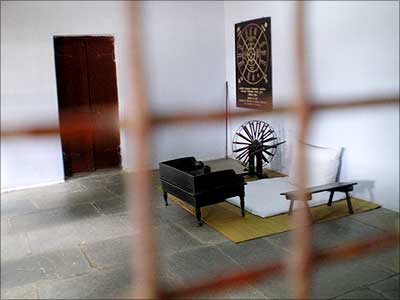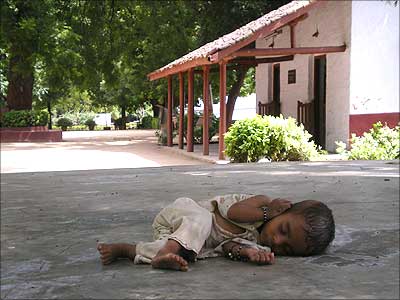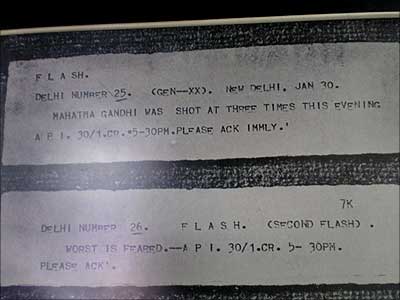Sitting on the scorching sands of her banks, Sultan Ahmed Shah had the urge to establish a capital here in the 15th century, which he did and it was named Ahmedabad after him. Before him, Solanki king Karandev I established a base on this river.
But kings and sultans completely pale in greatness when one remembers the indomitable leader who sat by the banks of the Sabarmati and dreamed of world peace and freedom for India.
Even 60 years later, the sun-dappled, spartan Sabarmati Ashram, located in the heart of blazingly hot and bustling Ahmedabad, is a serene, supremely peaceful location where Time has stood still. It has halted in memory of one of India's greatest human beings.
Enter the ashram and you feel that Gandhiji's soul continues to reside here.

The little cottage, with its red-tiled roof and shady courtyard nestling under neem, mimosa and pomegranate trees, looks out onto a clearing. The Sabarmati flows quietly in front of it.
The only sounds around here are of twittering birds and chattering squirrels.
The complex is reverently maintained by a group of aging Gandhians who urge you to take off your shoes before entering the leader's modest home.
A walk through the rooms introduces you to the simple life Gandhiji led here. The ashram has hardly any furniture.
Gandhiji helped with the daily chores. He bathed in the Sabarmati and was often engaged in prayers, long walk and correspondence, when he was not working out strategies to help India gain her Independence.
At different times, the ashram was occupied by Mahadev Desai, Gandhiji's secretary, freedom fighter Sardar Vallabhai Patel, Mani Ben (Patel's daughter) and Miss Madelaine Slade (Mira Ben), the British woman who worked with Gandhi.

Sabarmati Ashram was Gandhiji's home from 1917 onwards, when he returned from South Africa.
This site was chosen because it was a bit far from the city (at the time) and was located close to a British prison filled with Indian prisoners, whose suffering Gandhiji felt would motivate his struggle.
Gandhiji had reasons for making his home state his base. He said: 'Being a Gujarati, I'll serve my country best through the use of the Gujarati language. As Ahmedabad was the centre of the handloom in early days, the work of spinning wheel (charkha) could be done in a better way, I believed. Being the capital of Gujarat, its wealthy persons will also make a larger contribution, I hoped.'
The ashram is located on a 36 acre plot that was once mostly jungle. Across the Sabarmati river was the city of Ahmedabad and its mills.

The charkha, seen here in the room where he lived, was always by Gandhiji's side. It was his symbol of boycott of foreign-made goods and part of his non-cooperation theme.
He was arrested in March 1922 for the success of the non-cooperation movement and sentenced to a six year sentence for sedition at the very prison that adjoined the ashram. He spent two years there before being released for an appendicitis operation.
After his release from jail, he devoted time towards solving India's problems of destitution, untouchability and literacy, while prodding the conflict-ridden Indian National Congress to present a united front.

A few steps away is the little hut where Mira Ben lived.
This Britisher devoted her life to Gandhi's principles and named herself after Krishna's famed female devotee, Mirabai.



